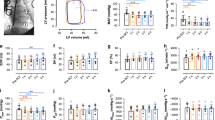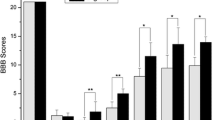Abstract
Purpose
In the acute phase of spinal cord injury (SCI), ischemia and parenchymal hemorrhage are believed to worsen the primary lesions induced by mechanical trauma. To minimize ischemia, keeping the mean arterial blood pressure above 85 mmHg for at least 1 week is recommended, and norepinephrine is frequently administered to achieve this goal. However, no experimental study has assessed the effect of norepinephrine on spinal cord blood flow (SCBF) and parenchymal hemorrhage size. We have assessed the effect of norepinephrine on SCBF and parenchymal hemorrhage size within the first hour after experimental SCI.
Methods
A total of 38 animals were included in four groups according to whether SCI was induced and norepinephrine injected. SCI was induced at level Th10 by dropping a 10-g weight from a height of 10 cm. Each experiment lasted 60 min. Norepinephrine was started 15 min after the trauma. SCBF was measured in the ischemic penumbra zone surrounding the trauma epicenter using contrast-enhanced ultrasonography. Hemorrhage size was measured repeatedly on parasagittal B-mode ultrasonography slices.
Results
SCI was associated with significant decreases in SCBF (P = 0.0002). Norepinephrine infusion did not significantly modify SCBF. Parenchymal hemorrhage size was significantly greater in the animals given norepinephrine (P = 0.0002).
Conclusion
In the rat, after a severe SCI at the Th10 level, injection of norepinephrine 15 min after SCI does not modify SCBF and increases the size of the parenchymal hemorrhage.





Similar content being viewed by others
References
Cadotte DW, Fehlings MG (2011) Spinal cord injury: a systematic review of current treatment options. Clin Orthop Relat Res 469:732–741
Broughton BR, Reutens DC, Sobey CG (2009) Apoptotic mechanisms after cerebral ischemia. Stroke 40:331–339
Wallace MC, Tator CH, Frazee P (1986) Relationship between posttraumatic ischemia and hemorrhage in the injured rat spinal cord as shown by colloidal carbon angiography. Neurosurgery 18:433–439
Noble LJ, Wrathall JR (1989) Correlative analyses of lesion development and functional status after graded spinal cord contusive injuries in the rat. Exp Neurol 103:34–40
Blight AR (1983) Cellular morphology of chronic spinal cord injury in the cat: analysis of myelinated axons by line-sampling. Neuroscience 10:521–543
Shen XF, Zhao Y, Zhang YK et al (2009) A modified ferric tannate method for visualizing a blood vessel and its usage in the study of spinal cord injury. Spinal Cord 47:852–856
Mautes AE, Weinzierl MR, Donovan F et al (2000) Vascular events after spinal cord injury: contribution to secondary pathogenesis. Phys Ther 80:673–687
Heiss WD (2010) The concept of the penumbra: can it be translated to stroke management? Int J Stroke 5:290–295
Casha S, Christie S (2011) A systematic review of intensive cardiopulmonary management after spinal cord injury. J Neurotrauma 28:1479–1495
Ploumis A, Yadlapalli N, Fehlings MG et al (2010) A systematic review of the evidence supporting a role for vasopressor support in acute SCI. Spinal Cord 48:356–362
Muzevich KM, Voils SA (2009) Role of vasopressor administration in patients with acute neurologic injury. Neurocrit Care 11:112–119
Consortium for Spinal Cord Medicine (2008) Early acute management in adults with spinal cord injury: a clinical practice guideline for health-care professionals. J Spinal Cord Med 31:403–479
Guha A, Tator CH, Piper I (1987) Effect of a calcium channel blocker on posttraumatic spinal cord blood flow. J Neurosurg 66:423–430
Guha A, Tator CH, Smith CR et al (1989) Improvement in post-traumatic spinal cord blood flow with a combination of a calcium channel blocker and a vasopressor. J Trauma 29:1440–1447
Guha A, Tator CH, Rochon J (1989) Spinal cord blood flow and systemic blood pressure after experimental spinal cord injury in rats. Stroke 20:372–377
Martirosyan NL, Feuerstein JS, Theodore N et al (2011) Blood supply and vascular reactivity of the spinal cord under normal and pathological conditions. J Neurosurg Spine 15:238–251
Soubeyrand M, Laemmel E, Dubory A, Vicaut E, Court C, Duranteau J (2012) Real-time and spatial quantification using contrast-enhanced ultrasonography of spinal cord perfusion during experimental spinal cord injury. Spine (Phila Pa 1976) 37(22):1376–1382. doi:10.1097/BRS.0b013e318269790f
Soubeyrand M, Laemmel E, Court C, Dubory A et al (2013) Rat model of spinal cord injury preserving dura mater integrity and allowing measurements of cerebrospinal fluid pressure and spinal cord blood flow. Eur Spine J 22:1810–1819
Fehlings MG, Tator CH, Linden RD (1989) The relationships among the severity of spinal cord injury, motor and somatosensory evoked potentials and spinal cord blood flow. Electroencephalogr Clin Neurophysiol 74:241–259
Fehlings MG, Tator CH, Linden RD (1989) The effect of nimodipine and dextran on axonal function and blood flow following experimental spinal cord injury. J Neurosurg 71:403–416
Dolan EJ, Tator CH (1980) The treatment of hypotension due to acute experimental spinal cord compression injury. Surg Neurol 13:380–384
Wallace MC, Tator CH (1987) Successful improvement of blood pressure, cardiac output, and spinal cord blood flow after experimental spinal cord injury. Neurosurgery 20:710–715
Wallace MC, Tator CH (1986) Failure of naloxone to improve spinal cord blood flow and cardiac output after spinal cord injury. Neurosurgery 18:428–432
Gambardella G, Collufio D, Caruso GN et al (1995) Experimental incomplete spinal cord injury: treatment with a combination of nimodipine and adrenaline. J Neurosurg Sci 39:67–74
Ross IB, Tator CH (1991) Further studies of nimodipine in experimental spinal cord injury in the rat. J Neurotrauma 8:229–238
Dyste GN, Hitchon PW, Girton RA et al (1989) Effect of hetastarch, mannitol, and phenylephrine on spinal cord blood flow following experimental spinal injury. Neurosurgery 24:228–235
Parke WW (2004) Arteriovenous glomeruli of the human spinal cord and their possible functional implications. Clin Anat 17:558–563
Bozzo A, Marcoux J, Radhakrishna M et al (2011) The role of magnetic resonance imaging in the management of acute spinal cord injury. J Neurotrauma 28:1401–1411
Willmot M, Leonardi-Bee J, Bath PM (2004) High blood pressure in acute stroke and subsequent outcome: a systematic review. Hypertension 43:18–24
Levi L, Wolf A, Belzberg H (1993) Hemodynamic parameters in patients with acute cervical cord trauma: description, intervention, and prediction of outcome. Neurosurgery 33:1007–1016 (discussion 16–17)
Vale FL, Burns J, Jackson AB et al (1997) Combined medical and surgical treatment after acute spinal cord injury: results of a prospective pilot study to assess the merits of aggressive medical resuscitation and blood pressure management. J Neurosurg 87:239–246
Anderson DK, Nicolosi GR, Means ED et al (1978) Effects of laminectomy on spinal cord blood flow. J Neurosurg 48:232–238
Griffiths IR, Trench JG, Crawford RA (1979) Spinal cord blood flow and conduction during experimental cord compression in normotensive and hypotensive dogs. J Neurosurg 50:353–360
Acknowledgments
None of the authors received funding for the present study. Stephanie Gorgeard (Toshiba, France) and Christophe Lazare (Bracco, France) are acknowledged.
Conflict of interest
The ultrasound device was lent by the society Toshiba, but none of the authors received fundings from Toshiba.
Bioethic committee
All the methods used in this experimental animal study were approved by the bioethics committee of the Lariboisière School of Medicine, Paris, France. Reference = CEEALV/2011-08-01.
Author information
Authors and Affiliations
Corresponding author
Additional information
A. Dubory and E. Laemmel have equally contributed to this work. E. Vicaut and J. Duranteau have equally contributed to this work.
Rights and permissions
About this article
Cite this article
Soubeyrand, M., Dubory, A., Laemmel, E. et al. Effect of norepinephrine on spinal cord blood flow and parenchymal hemorrhage size in acute-phase experimental spinal cord injury. Eur Spine J 23, 658–665 (2014). https://doi.org/10.1007/s00586-013-3086-9
Received:
Revised:
Accepted:
Published:
Issue Date:
DOI: https://doi.org/10.1007/s00586-013-3086-9




